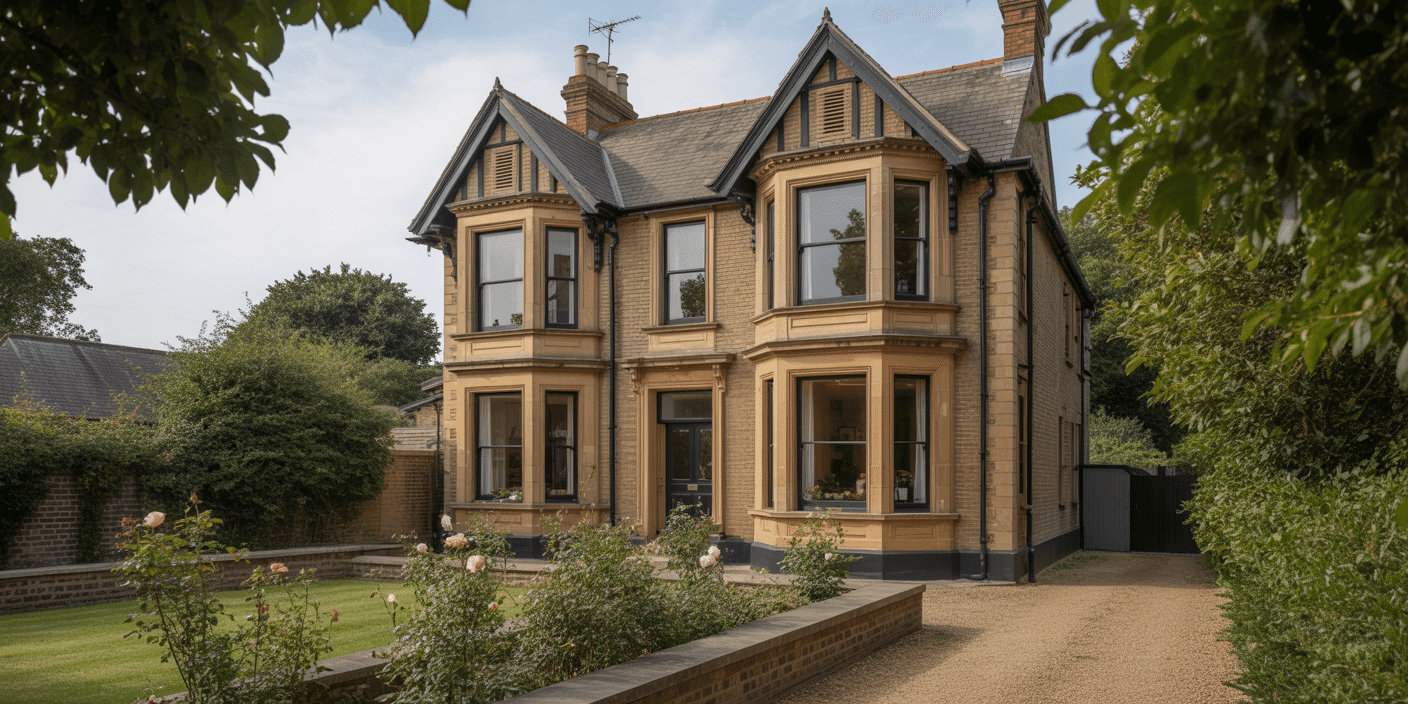The Quiet War Between Preservation and Performance
In conservation areas across the UK, a silent tension governs every upgrade decision: the desire to modernise versus the obligation to preserve.
Consider the period property — its sash windows, aged brickwork, and architectural symmetry. These features define the building’s character, and by extension, its protected status. Yet behind their charm lies a harsher reality: uncontrolled heat loss, compromised security, and soaring energy costs.
Improving performance is no longer optional. With regulatory pressures mounting — particularly under Part L of the Building Regulations — homeowners must meet modern thermal standards without altering the very elements planning officers are sworn to protect.
This creates a complex and often misunderstood challenge. Most window replacements fall into one of two traps:
- A contemporary unit that delivers performance but fails the aesthetic test,
- Or a superficial heritage replica that looks the part but performs little better than the original single-glazing.
Neither will satisfy both planning authorities and building control.
Neither resolves the core conflict between compliance, design integrity, and long-term comfort.
Addressing this challenge requires more than a product. It demands a system—a planning-ready, conservation-approved, performance-driven window solution engineered from the ground up.
Few companies understand this intersection. Fewer still have built their reputation upon it.
What Passive Windows Actually Are — and What They Aren’t
Let’s clear the air.
The term “passive window” is thrown around far too loosely. One installer adds a bit of weather-stripping and calls it passive. Another slaps in a triple-glazed unit and claims Part L victory. But here’s the truth: most “passive” windows aren’t even close.
A true passive window isn’t defined by a buzzword—it’s defined by numbers.
- U-value: ≤ 1.4 W/m²K (and ideally below 1.0 for deep retrofit or Passivhaus contexts)
- Airtightness: part of a building envelope with air changes below 0.6 ACH
- Thermal bridge prevention: achieved through thermally broken frames, warm edge spacers, and intelligent joinery
- Security compliance: PAS 24 tested hardware for ground-floor and accessible locations
- Visual integrity: designed to look indistinguishable from original frames, especially in conservation areas
Here’s what a passive window is not:
- A bulky, modern-looking frame that alienates planners
- A PVC unit with fake Georgian bars and awkward sightlines
- A well-intentioned double-glazed timber replacement with no certification
In short: a real passive window must perform under scrutiny—from planners, from engineers, from building control. It doesn’t just look the part; it proves it.
Most suppliers aren’t willing (or equipped) to go this far.
But one quietly has.
Not because it’s easy.
Because it’s necessary.
The Regulations That Could Derail Your Renovation

Your sash windows aren’t just charming relics. They’re structural, thermal, and legal obligations—whether you realise it or not.
In the UK, replacing or upgrading windows—especially in a conservation area—means navigating a triad of regulatory forces. These aren’t advisory. They’re mandatory. And failure to meet them can mean:
- Rejected planning applications
- Voided warranties
- Compliance penalties
- Insurance complications
- Post-installation removals at your cost
Let’s break down the three regulations that stand between you and a successful window upgrade:
Part L – Thermal Performance
Part L of the Building Regulations demands improved energy efficiency in all dwellings. For replacement windows, this typically means achieving a U-value of ≤ 1.4 W/m²K.
But here’s the catch:
Achieving that in a conservation-friendly window is not easy. You can’t just bulk up the glass or thicken the frames. Doing so risks distorting sightlines or triggering rejection from planners.
That’s why passive window systems must be engineered around visual constraints, using:
- Slimline triple glazing
- Warm-edge spacer bars
- High-spec low-E coatings
- Invisible airtight seals
All while preserving the illusion of original joinery.
Part Q – Security (PAS 24)
If your windows are accessible (ground floor or balcony), they must meet Part Q—the security regulation introduced in 2015.
That means:
- Multi-point locking
- Laminated or toughened glass
- PAS 24-certified hardware and frame resistance
Conservation-friendly? Rarely. Most heritage windows fail these standards outright.
But not all. Some have been silently engineered to achieve PAS 24 compliance, even under traditional aesthetics. It’s not marketing—it’s laboratory-tested performance.
Part K – Safety from Falling
Part K protects against falls from height—particularly relevant for sash windows above the ground floor. It mandates:
- Safe sill heights
- Opening restrictors
- Safety glass where required
While rarely discussed during purchase, Part K can be a reason for planning rejection, especially when replacing old windows with larger or deeper openings.
The solution? Integrate restrictors and safety features within the sash design, not as visible afterthoughts.
Here’s the reality:
A window that looks perfect but fails regulation is a legal liability.
A window that passes regulation but looks modern is a planning nightmare.
You need both. And that requires more than a catalogue — it requires a window system engineered with planning in mind.
And that’s where the story begins to change.
Conservation Areas: Aesthetic Imperatives and Planning Tensions
Conservation areas are not simply postcode designations—they are guardians of visual continuity. Every window, every glazing bar, every shadow line contributes to the character of a street, a neighbourhood, a legacy.
And planners?
They’re not there to argue efficiency. They’re there to protect sightlines, symmetry, and architectural intent.
So when you propose a new window—no matter how efficient, secure, or modern—you’re entering a realm where aesthetic fidelity is the gatekeeper.
What Planners Actually Look For
Most homeowners assume it’s about the material. Timber vs PVC. True, but only partially.
What planners really care about is visual authenticity, including:
- Glazing bar positioning and thickness
- Meeting rail height and profile
- Frame depth and visibility from the street
- Putty lines, horns, sash proportions
- Timber grain or wood-effect surface quality
Even a 10mm shift in sightline can be enough for a rejection.
So you can’t just “match it closely”. You must mirror it invisibly.
The Reversibility Rule
One of the central planning doctrines in conservation areas is reversibility.
“If the window can be replaced in future without damage to the original structure, and without evidence of intrusion, it may be considered permissible.”
That means:
- No expanding openings
- No disrupting original reveals
- No structural insertions
- No visible plastic or composite clashes
Everything must appear as if nothing has changed—while everything has.
Traditional Materials vs Modern Performance
Planners prefer traditional timber. But traditional timber alone rarely meets modern U-values or Part Q standards without modification.
That’s the core tension:
- Timber alone is aesthetic, but thermally weak
- Modern systems are compliant but visually jarring
Passive window planning must solve both.
How?
By using:
- Slim-profile triple glazing with heritage putty bevels
- Alu-clad or laminated timber cores masked with timber aesthetics
- Concealed security hardware within traditional joinery profiles
These are not off-the-shelf solutions.
They are engineered responses to aesthetic demands and legislative depth.
In conservation areas, the window is no longer just a frame—it’s a statement of respect, and a test of sophistication.
Most window suppliers simply don’t play at this level.
But one does.
Why Most Windows Fail Planning (and What to Do Instead)
Let’s speak plainly:
Most window replacements proposed in conservation areas are rejected.
Not because planners are difficult.
Not because heritage rules are unfair.
But because the submissions are lazy, shallow, or aesthetically tone-deaf.
At Sash Windows London, we’ve reviewed thousands of applications—and the patterns are painfully clear.
The 3 Most Common Causes of Rejection
- Poor Visual Fidelity
“Like-for-like” is not a design style. It’s a legal threshold.
Most suppliers stretch that phrase beyond recognition—offering PVC profiles with stick-on bars and claiming it matches Georgian timber. Planners notice. They always do.
- Incomplete Planning Documentation
If your drawings don’t show section views, thermal reports, and historic references, you’re asking planners to make assumptions—and they won’t.
Too many submissions are simply product brochures with window dimensions. That won’t pass.
- Misunderstanding the Burden of Proof
In a conservation area, you must prove that your proposed window will preserve the character of the property.
That means:
- Line drawings
- Joinery section details
- Glazing bar dimensions
- Sightline overlays
- Precedent examples
No planner will do this work for you. It must come built into your proposal.
The Better Way: Submission Built for Approval
At Sash Windows London, we take a forensic approach to planning. Our Passive Window systems come with:
Planning Approval Packs, including:
- Detailed elevation and joinery sections
- Sightline comparison overlays
- Thermal and acoustic simulations
- Conservation-friendly material samples
- Precedent case studies of approved properties
- Advisory notes aligned with local planning language
We don’t just give you a compliant window—we give you an approval strategy.
Planners have described our documentation as “plug and play.”
Architects have built entire submissions around our spec packs.
If your goal is approval on the first submission—not the third—
If your home is worth more than guesswork—
If you’d rather prevent rejection than repair it—
Then you need more than a good window.
You need a system built to pass.
The Secret to Passive, Compliant, Conservation Windows

Here’s a simple truth no one tells you:
Planning officers don’t hate modern performance.
They hate the modern appearance that disregards heritage.
So the real challenge isn’t about choosing between tradition and thermal efficiency.
It’s about knowing how to disguise one inside the other.
At Sash Windows London, we’ve spent over a decade perfecting the art of invisibility:
Creating windows that planners accept, conservationists respect, and building inspectors approve—all in one submission.
It’s Not One Window — It’s a System
The passive-compliant heritage window isn’t a single product. It’s a precisely engineered system, layered with invisible sophistication:
- Core Construction:
Slimline composite or alu-clad timber frames, preserving the depth and texture of true timber sashes while delivering ultra-low maintenance and structural stability. - Thermal Performance:
High-spec triple glazing, argon-filled units, low-E coatings, and warm-edge spacers drive down U-values—often below 1.0 W/m²K. - Aesthetic Fidelity:
Glazing bars set to historical dimensions. Joinery profiles that echo originals. Even putty lines replicated, not pasted. - Security Integration:
PAS 24-certified locks and catches, built into the sash rail—not bolted on as an afterthought. - Fall & Safety Compliance:
Hidden restrictors and safety glass meeting Part K, discreetly engineered into the build. - Planning Intelligence:
Every window comes backed by Planning Packs engineered to satisfy even the most detail-oriented officers.
This is more than product design. It’s a regulatory chess match played in millimetres and sightlines.
Case in Point: The Bath Project
A client in a Grade II-listed Georgian terrace in Bath approached us after two rejections from planning. Their architect had specified high-performance units, but planners pushed back on visible frame width and bar detailing.
Our team re-engineered the window profile—reducing external frame presence by 8mm, and matching glazing bar proportions from 1837 estate patterns.
We resubmitted with updated joinery sections, thermal reports, and precedent imagery.
Approved. No conditions. First submission.
Planner’s note: “A visually indistinguishable upgrade with remarkable integrity.”
That’s the secret.
It’s not just what you install.
It’s how well you understand the battlefield.
At Sash Windows London, we don’t make guesses.
We make passive window systems designed to win approvals without compromise.
Planning, Performance, and Peace of Mind
It’s easy to underestimate the emotional toll of upgrading windows in a conservation area.
What begins as a simple intention — to improve warmth, reduce bills, and future-proof your home — quickly becomes a stress-laden maze of planning conditions, building regulations, and aesthetic scrutiny.
And here’s the irony:
Most homeowners don’t discover how serious it all is until it’s already gone wrong.
A rejection letter. A missed deadline. An architect’s sigh over a second round of revisions.
But it doesn’t have to be that way.
Planning Success, Engineered In
When passive performance, heritage design, and regulation compliance are built into the product from day one, everything downstream gets easier:
- Planners engage, rather than push back
- Installers fit once — not twice
- You sleep without chasing Part L, Q or K retrospectively
- And your building control officer leaves impressed, not interrogating
This is what it means to build windows around planning — not the other way around.
Long-Term Security in Every Sense
A conservation property isn’t just a home — it’s an investment, a legacy, often a family’s anchor. The wrong window system can jeopardise:
- Your property value
- Your insurance rating
- Your EPC rating
- Your compliance under future standards
- Your reputation with your planning officer (yes, that matters)
But when you choose a partner who’s walked this tightrope hundreds of times before, you reclaim control.
Not just over compliance — but over certainty.
The Outcome Is Peace of Mind
You want windows that hold heat, pass regs, satisfy planners, and last a generation.
You want solutions that feel elegant, not engineered in desperation.
And most of all, you want to know that once it’s installed, you’ll never have to explain or justify it — because it simply works, and looks exactly as it should.
That’s what peace of mind looks like.
That’s what we build — quietly, consistently, compliantly.
Book Your Passive Planning Consultation
You’ve now seen what most homeowners never do.
You understand the stakes:
✔️ Regulatory failure
✔️ Planning rejection
✔️ Thermal inefficiency
✔️ Aesthetic compromise
You also know this isn’t just about windows.
It’s about protecting your home’s future — legally, architecturally, financially.
Most window companies stop at “heritage style” or “energy efficient.”
Sash Windows London goes further.
We design, manufacture, and install passive window systems that pass planning, exceed performance thresholds, and preserve architectural integrity — all in one solution.
No guesswork. No jargon. Just engineered certainty.
What Happens in Your Consultation?
Your Passive Planning Consultation includes:
- U-value & glazing performance guidance
- Conservation-area planning strategy
- Joinery advice tailored to your elevation
- Preview of our full Planning Approval Pack
- Material samples and precedent imagery
- Optional site survey to assess installation viability
Whether you’re renovating a single sash or an entire elevation, this session gives you a crystal-clear roadmap.
Book Now — Before You Submit Anything
Too many homeowners come to us after their application is rejected.
Too many architects wish they’d involved us sooner.
Too many planning delays could have been avoided with a single, strategic consultation.
This is your moment to get it right the first time.
👉 Book Your Passive Planning Consultation
Zero obligation. Total clarity. Built to win approval.
Because the best window decision you’ll ever make —
starts before the window is even made.







